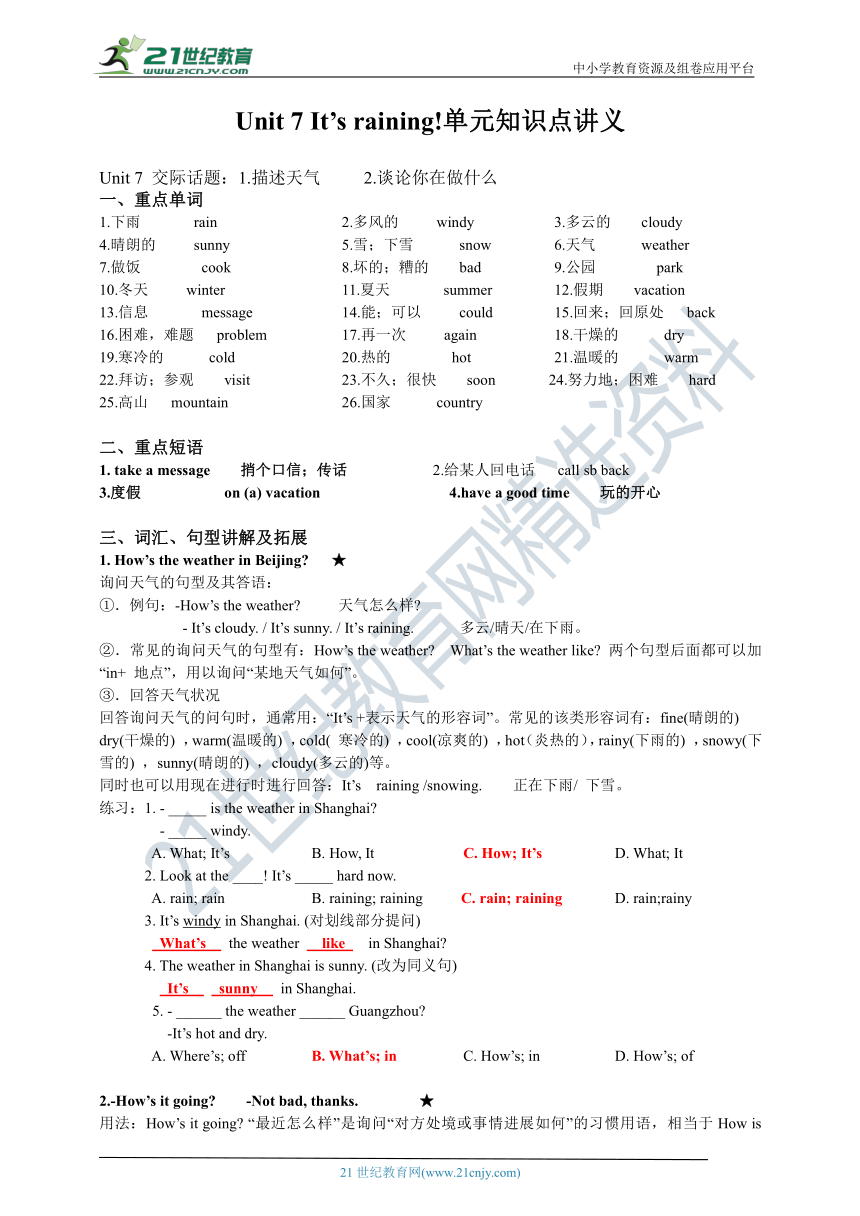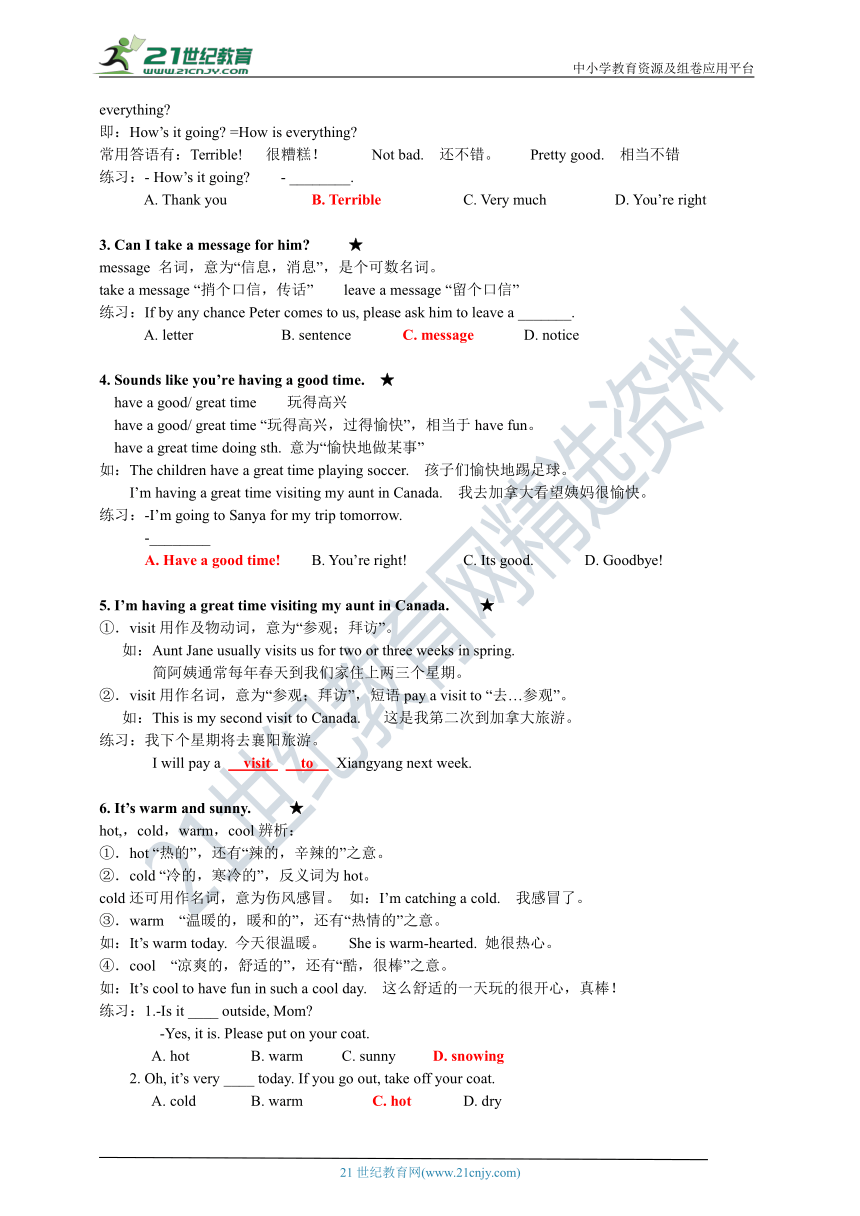Unit 7 It’s raining!单元知识点讲义
文档属性
| 名称 | Unit 7 It’s raining!单元知识点讲义 |  | |
| 格式 | zip | ||
| 文件大小 | 1.2MB | ||
| 资源类型 | 试卷 | ||
| 版本资源 | 人教新目标(Go for it)版 | ||
| 科目 | 英语 | ||
| 更新时间 | 2020-02-05 16:26:15 | ||
图片预览


文档简介
中小学教育资源及组卷应用平台
Unit 7 It’s raining!单元知识点讲义
Unit 7 交际话题:1.描述天气 2.谈论你在做什么
一、重点单词
1.下雨 rain 2.多风的 windy 3.多云的 cloudy
4.晴朗的 sunny 5.雪;下雪 snow 6.天气 weather
7.做饭 cook 8.坏的;糟的 bad 9.公园 park
10.冬天 winter 11.夏天 summer 12.假期 vacation
13.信息 message 14.能;可以 could 15.回来;回原处 back
16.困难,难题 problem 17.再一次 again 18.干燥的 dry
19.寒冷的 cold 20.热的 hot 21.温暖的 warm
22.拜访;参观 visit 23.不久;很快 soon 24.努力地;困难 hard
25.高山 mountain 26.国家 country
二、重点短语
1. take a message 捎个口信;传话 2.给某人回电话 call sb back
3.度假 on (a) vacation 4.have a good time 玩的开心
三、词汇、句型讲解及拓展
1. How’s the weather in Beijing? ★
询问天气的句型及其答语:
①.例句:-How’s the weather? 天气怎么样?
- It’s cloudy. / It’s sunny. / It’s raining. 多云/晴天/在下雨。
②.常见的询问天气的句型有:How’s the weather? What’s the weather like? 两个句型后面都可以加“in+ 地点”,用以询问“某地天气如何”。
③.回答天气状况
回答询问天气的问句时,通常用:“It’s +表示天气的形容词”。常见的该类形容词有:fine(晴朗的)
dry(干燥的) ,warm(温暖的) ,cold( 寒冷的) ,cool(凉爽的) ,hot(炎热的),rainy(下雨的) ,snowy(下雪的) ,sunny(晴朗的) ,cloudy(多云的)等。
同时也可以用现在进行时进行回答:It’s raining /snowing. 正在下雨/ 下雪。
练习:1. - _____ is the weather in Shanghai?
- _____ windy.
A. What; It’s B. How, It C. How; It’s D. What; It
2. Look at the ____! It’s _____ hard now.
A. rain; rain B. raining; raining C. rain; raining D. rain;rainy
3. It’s windy in Shanghai. (对划线部分提问)
What’s the weather like in Shanghai?
4. The weather in Shanghai is sunny. (改为同义句)
It’s sunny in Shanghai.
5. - ______ the weather ______ Guangzhou?
-It’s hot and dry.
A. Where’s; off B. What’s; in C. How’s; in D. How’s; of
2.-How’s it going? -Not bad, thanks. ★
用法:How’s it going? “最近怎么样”是询问“对方处境或事情进展如何”的习惯用语,相当于How is everything?
即:How’s it going? =How is everything?
常用答语有:Terrible! 很糟糕! Not bad. 还不错。 Pretty good. 相当不错
练习:- How’s it going? - ________.
A. Thank you B. Terrible C. Very much D. You’re right
3. Can I take a message for him? ★
message 名词,意为“信息,消息”,是个可数名词。
take a message “捎个口信,传话” leave a message “留个口信”
练习:If by any chance Peter comes to us, please ask him to leave a _______.
A. letter B. sentence C. message D. notice
4. Sounds like you’re having a good time. ★
have a good/ great time 玩得高兴
have a good/ great time “玩得高兴,过得愉快”,相当于have fun。
have a great time doing sth. 意为“愉快地做某事”
如:The children have a great time playing soccer. 孩子们愉快地踢足球。
I’m having a great time visiting my aunt in Canada. 我去加拿大看望姨妈很愉快。
练习:-I’m going to Sanya for my trip tomorrow.
-________
A. Have a good time! B. You’re right! C. Its good. D. Goodbye!
5. I’m having a great time visiting my aunt in Canada. ★
①.visit用作及物动词,意为“参观;拜访”。
如:Aunt Jane usually visits us for two or three weeks in spring.
简阿姨通常每年春天到我们家住上两三个星期。
②.visit用作名词,意为“参观;拜访”,短语pay a visit to “去…参观”。
如:This is my second visit to Canada. 这是我第二次到加拿大旅游。
练习:我下个星期将去襄阳旅游。
I will pay a visit to Xiangyang next week.
6. It’s warm and sunny. ★
hot,,cold,warm,cool辨析:
①.hot “热的”,还有“辣的,辛辣的”之意。
②.cold “冷的,寒冷的”,反义词为hot。
cold还可用作名词,意为伤风感冒。 如:I’m catching a cold. 我感冒了。
③.warm “温暖的,暖和的”,还有“热情的”之意。
如:It’s warm today. 今天很温暖。 She is warm-hearted. 她很热心。
④.cool “凉爽的,舒适的”,还有“酷,很棒”之意。
如:It’s cool to have fun in such a cool day. 这么舒适的一天玩的很开心,真棒!
练习:1.-Is it ____ outside, Mom?
-Yes, it is. Please put on your coat.
A. hot B. warm C. sunny D. snowing
2. Oh, it’s very ____ today. If you go out, take off your coat.
A. cold B. warm C. hot D. dry
7. It’s hot in your country now, isn’t it? ★★
这是一个反义疑问句。反意疑问句即附加疑问句,用来询问对方的看法或对某事没有把握需要对方证实。反意疑问句由两部分组成:“陈述句+简短的疑问句”,两部分的人称及时态应保持一致。反意疑问句遵循以下原则:
.陈述部分肯定+疑问部分否定
.陈述部分否定+疑问部分肯定。
It’s rainy today, isn’t it? 今天下雨,不是吗?
Tom didn’t like vegetables ,did he? 汤姆不喜欢蔬菜,是吗?
-They work hard, don’t they? 他们工作努力,不是吗?
-Yes, they do / No, they don’t. 是的,他们工作努力。/ 不,他们工作不努力。
练习:1.-Your brother often disagrees with you, ______ he?
-_______.We often have different opinions.
A. does; Yes B. doesn’t; Yes C. does; No D. doesn’t; No
2.【广州中考】I hear the tall girl wearing glasses is your new classmate. She’s from America, __________?
A. has she B. isn’t she C. hasn’t he D. does she
3.【哈尔滨中考】-There are always many volunteers in great events, _____?
-Yes. Many hands make light work!
A. aren’t there B. are there C. aren’t they D. are they
8. Mary is cooking. ★
cook用作动词,意为“做饭”,是及物动词。
如:She is cooking for her daughter. 她正在为女儿做饭。
【拓展】cook还可以用作名词,意为“厨师”,而cooker是指“厨具,锅 ”。
如:My father is a cook. 我的爸爸是个厨师。
练习:1.我爸爸是个厨师,他现在正在做饭。
My father is a cook . He is cooking now.
四、语法专项
1.How的用法归类:
①.用来询问身体状况。如:How are you? 你好吗?
②.用来询问动作执行的方式或手段。如:How do you go to school? 你怎样上学?
③.用来询问年龄。如:How old is she? 她多少岁?
④.用来询问天气。如:How’s the weather today? 今天天气怎么样?
⑤.How much用来询问价格,或对不可数名词数量提问。
如:How much chicken is there? 有多少鸡肉?
⑥.How many对可数名词数量提问。如:How many apples do you have? 你有几个苹果?
⑦.How far对路程提问。如:How far is it from school to your home? 从你家到学校有多远?
⑧.How often对事情发生频率提问。如:How often do you go to the movies? 你多久看一次电影?
练习:1. - _______ is the T-shirt? - 100 yuan.
A. How many B. How much C. How long D. How far
2. - ________? -Not bad.
A. How’s it go B. How do you spell it
C. How’s it going D. What’s it going
2.What引导的特殊疑问句:
基本结构有两种情况:①.What+一般疑问句?
②.What+名词+一般疑问句?(what后面跟上名词时,what起形容词作用)
具体的说:
系动词作谓语:What+系动词+sb/sth ? What+名词+系动词+sb/sth ?
如:What’s this? What color is it?
情态动词作谓语:What+情态动词+sb/sth+实意动词? What+名词+情态动词+sb/sth+实意动词?
如:What will you do after lunch?
行为动词作谓语:What+助动词+sb/sth+实意动词? What+名词+助动词+sb/sth+实意动词?
如:What color do you like?
助动词不能单独作谓语。
练习:1. - _____ the weather like today? -It’s cloudy.
A. What does B. What’s C. How’s D. How does
2. - What are you doing now?
- I’m _____. Breakfast will be OK soon.
A. running B. singing C. sleeping D. cooking
3.现在进行时用法的易错点:
①.遗漏be动词,如:The children playing (are playing) basketball.
现在进行时的构成是be+ v.ing形式,be是动词,没有实际意义,但却不能遗漏掉。
②.动词be运用错误。如:Jack and I am(are) playing basketball. 当主语为复数时,动词be用are。
③.遗漏动词后的- ing形式。如:Many girls are sing (singing) in the next room.
④.v.-ing构成错误。如:writeing (writing),以不发音的字母e结尾的动词去e,再加-ing。
runing(running),以重读闭音节结尾的词,若末尾只有一个辅音字母,应该双写这个字母,再加-ing。
listenning(listening),listen不是以重读闭音节结尾的词,因此直接加-ing。
⑤.对动作提问遗漏doing。
练习:1.-Are you working? (作肯定回答)
-Yes, I am .
2. Tom and Jack are playing basketball at the park. (对划线部分提问)
What are Tom and Jack doing at the park?
3. Jerry is reading a newspaper in the living room.(改为否定句)
Jerry isn’t reading a newspaper in the living room.
4.【义乌中考】-Hello! Is that Emily speaking?
-Sorry, this is Jack, Emily’s son. My mother _____ in the kitchen.
A. cooks B. cooking C. is cooking D. has cooked
21世纪教育网 www.21cnjy.com 精品试卷·第 2 页 (共 2 页)
HYPERLINK "http://21世纪教育网(www.21cnjy.com)
" 21世纪教育网(www.21cnjy.com)
同课章节目录
- Unit 1 Can you play the guitar?
- Section A
- Section B
- Unit 2 What time do you go to school?
- Section A
- Section B
- Unit 3 How do you get to school?
- Section A
- Section B
- Unit 4 Don't eat in class.
- Section A
- Section B
- Unit 5 Why do you like pandas?
- Section A
- Section B
- Unit 6 I'm watching TV.
- Section A
- Section B
- Review of Units 1-6
- Unit 7 It's raining!
- Section A
- Section B
- Unit 8 Is there a post office near here?
- Section A
- Section B
- Unit 9 What does he look like?
- Section A
- Section B
- Unit 10 I'd like some noodles.
- Section A
- Section B
- Unit 11 How was your school trip?
- Section A
- Section B
- Unit 12 What did you do last weekend?
- Section A
- Section B
